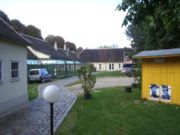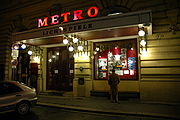
Filmarchiv Austria
Encyclopedia

Austria
Austria , officially the Republic of Austria , is a landlocked country of roughly 8.4 million people in Central Europe. It is bordered by the Czech Republic and Germany to the north, Slovakia and Hungary to the east, Slovenia and Italy to the south, and Switzerland and Liechtenstein to the...
n film record material: films themselves, literature about film and cinema, or film-related periodicals. With over 100,000 film titles, 2,000,000 photographs and stills, 25,000 cinema programmes, 10,000 film posters, 30,000 books, and an extensive collection of apparatus, documents and costumes, it is the largest such organisation in Austria.
Research is always in progress on particular topics in order to enlarge the film content, covering all genres from advertising footage to experimental projects to light entertainment films. Of all the still-extant Austrian productions in the world from before 1945, over 95% are kept in the Filmarchiv Austria.
The Filmarchiv Austria is a member of FIAF (the International Federation of Film Archives).
History

The first reconstruction of film material by the ÖFA, in 1961, was the 1926 film version of Der Rosenkavalier
Der Rosenkavalier
Der Rosenkavalier is a comic opera in three acts by Richard Strauss to an original German libretto by Hugo von Hofmannsthal. It is loosely adapted from the novel Les amours du chevalier de Faublas by Louvet de Couvrai and Molière’s comedy Monsieur de Pourceaugnac...
. Other major reconstruction projects have included the first Austrian feature film productions, those of Saturn-Film; the oldest extant Austrian drama film, Der Müller und sein Kind
Der Müller und sein Kind
Der Müller und sein Kind, a silent film made in 1911, is the oldest Austrian drama film to survive in its entirety. It was produced by the Österreichisch-Ungarische Kinoindustrie, which later in 1911 changed its name to become the Wiener Kunstfilm-Industrie...
of 1911; and the classics Orlacs Hände ("The Hands of Orlac") and Die Sklavenkönigin ("The Slave Queen" or "The Moon of Israel"), which without this work would have remained inaccessible to the viewing public.
The Filmarchiv Austria, together with Der Standard
Der Standard
Der Standard is an Austrian national daily newspaper which is published in Vienna . It was founded by Oscar Bronner as a financial newspaper and the first edition was published on 1988-10-19...
, is also responsible for the selection and production of Der österreichische Film, an authoritative DVD series of significant Austrian films, consisting so far of 50 parts.
In 1965 a systematic programme began of conversion of film prints on the highly unstable cellulose nitrate base, which remained in commercial use into the 1950s, to security film.
In 1968 new premises were found in the Rauhensteingasse in central Vienna
Vienna
Vienna is the capital and largest city of the Republic of Austria and one of the nine states of Austria. Vienna is Austria's primary city, with a population of about 1.723 million , and is by far the largest city in Austria, as well as its cultural, economic, and political centre...
, while new storage and exhibition facilities were established in the Altes Schloss ("Old Castle"), Laxenburg. In 1997 the Österreichische Filmarchiv changed its name to Filmarchiv Austria, and established new central facilities at the Audiovisuelles Zentrum Wien-Augarten.
In 2001 the Filmarchiv-Studienzentrum was opened in the Augarten
Augarten
The Augarten is a 52.2 hectare public park in Leopoldstadt, the second district of Vienna, Austria. It contains the oldest Baroque gardens of the city....
premises, incorporating the Filmdokumentationszentrum, formerly the largest private collection of film-related material in Austria, founded in 1965 by Herbert Holba and the film historian Peter Spiegel, on the basis of an earlier collection begin in 1945.
Collections

Some of the more important collections include:
- the Goldstaub collection: a highly significant collection from the early days of the Austrian cinema, with extensive documentary footage from the time of the monarchy;
- the Reinthaler collection: Austria's largest cinematic collection from the years 1910-20;
- the Köfinger collection: tourism films from the period of silent film;
- a number of collections of cine-newsreels from the 1930s;
- the archive of the major newsreel producer Austria Wochenschau, acquired in 1997

